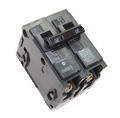|
» Home Electrical Wiring
» Electrical Wiring Directory
» Circuit Breakers and Fuses
» Need Electrical Help? Ask the Electrician
» Circuit Breakers and Fuses
» Need Electrical Help? Ask the Electrician
GFCI and AFCI Circuit Breakers
 |
Summary: Electric circuit protection with AFCI provide the extra measure of safety for your family. AFCI's are installed serving required house
wiring circuits protecting areas such as the bedrooms. AFCI protects the bedroom circuit devices against the danger of arcing which can lead to fire.
© By: Dave Rongey |
What are GFCI and AFCI Circuit Breakers?
The electric circuit breakers serving your home wiring circuits are intended for switching and protection of your home's wiring from high temperatures caused by excess current higher than the rating of the wire.
While thermal magnetic circuit breakers are the key element for overload and short circuit protection of your home electrical system, there are potentially dangerous conditions that do not involve overcurrent.
The following circuit breakers should be utilized to provide further protection with house wiring.
AFCI's can Prevent Sparks That Can Lead to a House Fire
 |
Combination Arc Fault Circuit Interrupters (AFCI)
 |
Combination AFCIs protect against all three possible types of arc fault: line to ground, line to neutral arcs, and series arcs and thus significantly reduce the risk of electrical fires. They feature a unique LED trip indicator, providing a valuable analysis tool to help to pinpoint the type of trip and reduce the time spent debugging the home electrical wiring circuits. |
Branch Feeder Arc Fault Circuit Interrupters (AFCI)
 |
AFCIs are new electrical safety devices used for some of the home electrical wiring circuits that provide protection against arcing faults. These devices recognize characteristics unique to arcing and de energize the circuit when an arc fault is detected. Arc faults may occur for many reasons such as worn electrical insulation or damaged wire, misapplied or damaged appliance cords and equipment, loose electrical connections, or driving a nail into a wall and having it inadvertently hit a wire. The possibility of arcing grows as a home ages since age and time will contribute to the possibility of these conditions occurring. |
Circuit Breakers and Surge Arresters
 |
One example of a circuit breaker with a built in surge arrestor is this transient voltage surge suppressor (TVSS) module which has a highly effective surge suppressor integrated with two 1-pole circuit breakers. Even the best point-of-entry surge protectors are subject to failure in the event of a catastrophic surge. Good surge protectors are designed to sacrifice themselves and not the connected equipment. Some surge protection devices provide visual indication that the surge protection circuitry is functional and protecting the connected equipment. If the indicator lights are not illuminated the home owner should replace the surge protector promptly. |
Common Brands of Home Electrical Circuit Breakers |
|
|
The Safest Way to Test Electrical Devices and Identify Electric Wires!The Non-Contact Electrical TesterThis is a testing tool that I have had in my personal electrical tool pouch for years, and is the first test tool I grab to help identify electrical wiring. It is a Non-contact tester that I use to easily Detect Voltage in Cables, Cords, Circuit Breakers, Lighting Fixtures, Switches, Outlets and Wires. Simply insert the end of the tester into an outlet, lamp socket, or hold the end of the tester against the wire you wish to test. Very handy and easy to use.
The Quickest Way to Check for Faulty Electrical Wiring!The Plug-In Outlet TesterThis is the first tool I grab to troubleshoot a problem with outlet circuit wiring. This popular tester is also used by most inspectors to test for power and check the polarity of circuit wiring. It detects probable improper wiring conditions in standard 110-125 VAC outlets Provides 6 probable wiring conditions that are quick and easy to read for ultimate efficiency Lights indicate if wiring is correct and indicator light chart is included Tests standard 3-wire outlets UL Listed Light indicates if wiring is incorrect Very handy and easy to use.
Strip Off Wire Insulation without Nicking and Damaging the Electric Wire!The Wire Stripper and Wire CutterMy absolute favorite wire stripping tool that I have had in my personal electrical tool pouch for years, and this is the tool I use to safely strip electrical wires. This handy tool has multiple uses: The wire gauges are shown on the side of the tool so you know which slot to use for stripping insulation. The end of the tool can be used to grip and bend wire which is handy for attaching wire onto the screw terminals of switches and outlets.. The wire stripper will work on both solid and stranded wire. This tool is Very Handy and Easy to Use. |
||
Circuit Breakers, Panels, Parts and AccessoriesCircuit Breaker Siemens ITE Circuit Breaker ITE GFCI Circuit Breaker ITE AFCI Circuit Breaker Square D Hot Tub Panel Sub Panel 120 240volt 100amp Sub Panel 120 240volt 125amp Panel 120 240volt 200amp |















